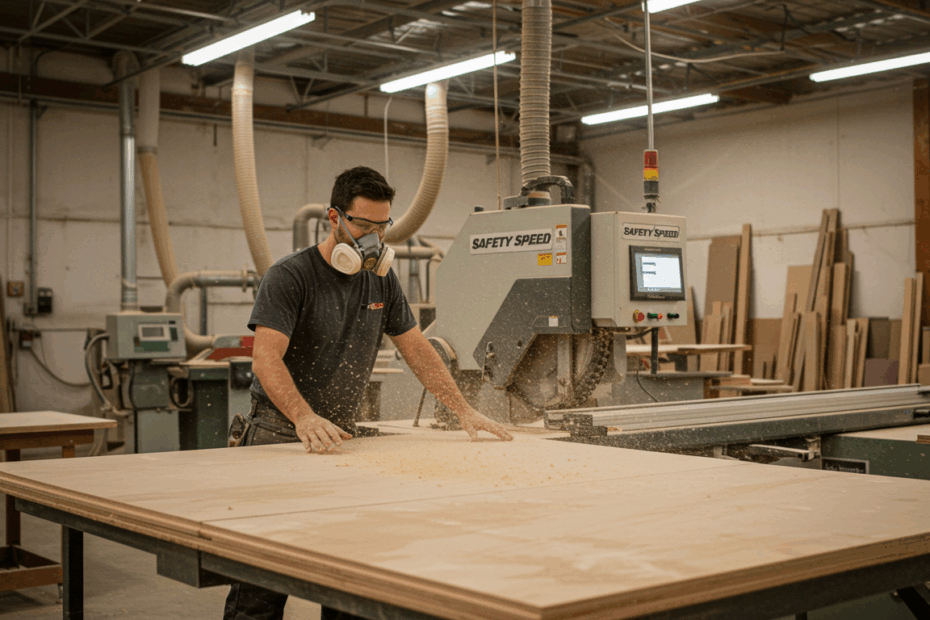
John: Welcome, readers. Today, we’re delving into a concept that’s been gaining traction in professional and creative circles: the “safety, speed” lifestyle. Now, this isn’t about the frantic pace of modern life. It’s a more deliberate philosophy, a mindset focused on achieving efficiency without sacrificing quality or well-being. It’s about working smarter, safer, and with more intention.
Lila: Hi everyone! I have to admit, John, when you first mentioned this topic, my mind went straight to digital productivity hacks or maybe even traffic safety technology. But when we started digging into what people are actually searching for when they look up “safety” and “speed,” a very different, much more tangible picture emerged. We’re not talking about apps or algorithms, are we?
John: Not in the way you might think. The data points us toward something far more solid, rooted in the physical world of making things. The search results consistently circle back to a specific entity: Safety Speed Manufacturing. They are a company that, for many, has come to embody this very ethos. Their entire identity is built on these two pillars.
Lila: So, this lifestyle concept is actually anchored by a real-world company and their products? That’s fascinating. It’s not just an abstract idea; it’s something people can literally build their workspace around. From what I saw, they’re a leading American manufacturer of some pretty serious equipment, right? Based out of Minnesota?
John: Precisely. Safety Speed Manufacturing is headquartered at 13943 Lincoln St NE, Ham Lake, MN 55304. For over half a century, they’ve been producing high-quality panel processing machinery. We’re talking about the foundational tools of a modern workshop: Vertical Panel Saws, Panel Routers, Wide Belt Sanders, Edgebanders, and even specialized equipment like Screw Pocket Machines. Their story is the bedrock of this conversation.
Lila: Okay, so let’s break that down for our readers who might be new to this world. When you say “panel processing machinery,” what kind of work are we talking about? Who is the person living this ‘Safety Speed’ lifestyle?
John: We’re talking about the craftspeople who build our world. Cabinet makers, furniture designers, sign makers, general woodworkers, and even plastics fabricators. Anyone who needs to take large sheets of material—like plywood, MDF, or acrylic—and process them with precision and efficiency. The ‘Safety Speed’ practitioner is the small business owner, the dedicated hobbyist, or the large production shop manager who understands that their output is only as good as their process.
Lila: It’s about professional craftsmanship, then. And a key part of their identity seems to be the “American Manufacturer” label. I saw that emphasized quite a bit in their social media and descriptions. Why is that specific detail so important to this lifestyle?
John: It’s a significant factor. In today’s global market, choosing American-made equipment is a conscious decision. For many, it signifies a commitment to a certain standard of build quality, material sourcing, and durability. There’s an implied trust in the engineering and a desire to support domestic industry. It also means that support and parts are typically more accessible. When a machine is the heart of your business, knowing it’s built to last and is backed by a local presence provides immense peace of mind. That reliability is a form of safety in itself—business safety.
Lila: That makes so much sense. So, the lifestyle starts with a foundational choice: investing in reliable, domestically-made tools. It’s about building your creative or business endeavors on a solid, trustworthy base. It’s not just a purchase; it’s a statement of values. That’s a powerful first step.
John: It is. And it leads us directly to the first pillar of the ethos: Safety. It’s right there in the name, and it’s not just for marketing. In a workshop environment, safety is paramount. The traditional methods of handling large, heavy sheet goods can be cumbersome and dangerous, often requiring two or three people and risking injury or material damage.
Lila: I can picture that. Trying to wrestle a giant sheet of plywood onto a table saw sounds like a recipe for disaster for a solo operator. How does the equipment itself address this? What makes a machine “safe” in this context?
John: Let’s take their core product, the Vertical Panel Saw. The very design is a safety innovation. The panel stands vertically in a sturdy frame, and the operator moves a lightweight cutting carriage along the material. This means the operator isn’t moving a 90-pound sheet of wood; they’re moving a tool that weighs a fraction of that. The material is stationary and secure. This immediately reduces physical strain and the risk of the panel slipping or kicking back, which is a notorious danger with table saws.
Lila: So the ergonomics are a huge part of the safety equation. It’s about changing the fundamental physics of the operation to favor the user. I did see a few unrelated search results that popped up about “speed safety cameras” in cities like Bellevue, which are automated devices to enforce speed limits. It seems like there’s a broader cultural conversation happening around using technology to engineer safer environments. Do you see a parallel?
John: That’s a very sharp observation, Lila. The parallel is definite, but the philosophy is slightly different. The traffic camera is a reactive or monitoring tool. The Safety Speed approach is proactive. The safety is engineered into the machine’s fundamental design. It’s about creating a system where the correct, safe operation is also the easiest and most efficient operation. The machine guides the user toward a safer process, rather than just policing for mistakes.
Lila: I like that distinction. It’s proactive versus reactive safety. So, investing in a vertical panel saw isn’t just about getting a tool that cuts wood; it’s about adopting a safer workflow for your entire shop. It fundamentally changes how you interact with your primary materials. What about their other machines? How does the safety principle apply to something like a sander?
John: Consider their Wide Belt Sanders. Hand-sanding or using smaller, less stable power sanders can lead to repetitive strain injuries and produce inconsistent results. A large, robust machine like a wide belt sander contains the sanding action within a heavy, stable frame. It provides a flat, consistent finish, which is a quality feature, but it also does so in a controlled environment. The user feeds the material through, but the aggressive work is done inside the machine, with dust collection ports that drastically improve air quality—another critical, often overlooked, safety aspect.
Lila: Better air quality is a huge one! The long-term health of the craftsperson is just as important as preventing immediate injury. So, the ‘Safety’ pillar of this lifestyle is comprehensive. It’s about ergonomic design, predictable operation, and a healthier work environment. It’s a holistic view of well-being in the workshop.
John: Exactly. And this brings us seamlessly to the second pillar: Speed. It’s crucial to understand that in this context, ‘speed’ does not mean ‘rushed.’ It means ‘efficient.’ It’s about removing bottlenecks, reducing wasted time and motion, and allowing the craftsperson to spend more time on the value-adding parts of their work—the design, the assembly, the finishing touches.

Lila: This is the part that I think really defines it as a modern lifestyle. People want to be productive, but not burnt out. So how does this ‘speed through efficiency’ manifest in the workshop? Can you give me a practical example?
John: Certainly. Let’s look at the Saw and Router Combination Machines. I saw several videos and posts from Safety Speed about these, and they’re a brilliant example of efficiency. In many shops, cutting panels and routing edges or grooves are two distinct, time-consuming steps, often requiring two large, separate machines that take up a lot of floor space.
Lila: Right, and in a small shop, floor space is gold. I saw one of their Instagram reels showing how you can convert the machine from a saw to a router. It looked surprisingly quick.
John: It is. The ability to swap the function of a single machine based on the task at hand is a massive time-saver. You’re not moving a heavy workpiece from one station to another. You’re not trying to calibrate two different machines. You perform one operation, make a quick changeover, and perform the next. This drastically reduces setup time, which is often the biggest time sink in a custom woodworking project. It’s speed born from versatility.
Lila: That’s a fantastic point. The time isn’t saved by the blade spinning faster, but by eliminating all the dead time in between cuts. It’s about optimizing the entire workflow. I saw another product that seemed to fit this theme perfectly: their edgebanders, like the 60HA model. The description mentioned “electronic variable speed control.” That sounds like a very deliberate approach to speed.
John: An excellent catch. That feature is the epitome of this philosophy. Edgebanding is the process of applying a thin strip of veneer or plastic to the raw edges of a panel, like on a cabinet door. The quality of the adhesion depends on the glue, the temperature, and the speed at which the material is fed. Too fast, and it won’t stick properly. Too slow, and the glue might burn or cure incorrectly. Electronic variable speed control allows the operator to dial in the *perfect* speed for the specific material and glue they’re using. It’s not about maximum speed; it’s about optimal speed for a flawless result.
Lila: That reminds me of another one of those outlier search results—a new 12 MPH speed limit for bikes on Marco Island. The goal wasn’t to make everyone go slow, but to establish a safe and appropriate speed for a shared path. It’s the same principle: finding the correct, effective speed for the context. So the ‘Speed’ in ‘Safety Speed’ is really about control and optimization.
John: Precisely. It’s intelligent speed. Another example is their Wide Belt Sander. A Facebook post I saw mentioned how using a single-head sander allows for “swapping out belts based on your project.” This agility is another form of speed. Instead of having a machine that’s a one-trick pony, you have a versatile tool that can be quickly adapted for aggressive material removal with a coarse grit belt, or for a fine, pre-finish polish with a high-grit belt. Less time spent fighting your tools, more time getting work done.
Lila: I also saw a YouTube short titled “10 Years of Reliability using an American Made Wide Belt Sander,” featuring a shop called The Natural Edge Woodworking. The owner said the machine “transformed their operation.” That’s a powerful testimonial. The speed here isn’t just about a single job; it’s about the long-term speed of a reliable business. Less downtime for maintenance or repairs means more uptime for production.
John: You’ve hit on a crucial, often-underestimated aspect of speed: reliability. A machine that breaks down is the biggest speed bump of all. A tool that works, day in and day out, for a decade or more, provides a consistent, predictable pace for a business. That long-term reliability is perhaps the ultimate form of speed, and it loops right back to the “American Made” quality we discussed earlier. It’s all interconnected.
Lila: This is a really deep concept. It’s a whole ecosystem of thought. Maybe we should walk through their main product lines one by one, to really paint a picture of how this ecosystem comes together in a workshop.
John: A great idea. Let’s start with the foundation: the Vertical Panel Saw. We’ve touched on its safety, but let’s talk specs. Looking at a model like their 7000 Series, you see features that speak to both safety and speed. For instance, one data sheet lists a max crosscut of 64 inches and a max cut thickness of 2 inches. But the key spec for me is often the cut accuracy, which was listed as being exceptionally high for both straightness and squareness.
Lila: Why is accuracy so critical for speed? I would think of it more as a quality metric.
John: Because inaccurate cuts create more work later. If your initial cuts aren’t perfectly square, your cabinet boxes won’t assemble correctly. Your joints will have gaps. You’ll spend hours trying to fix, fill, and sand errors that were created in the first five minutes of the project. A perfectly accurate cut from the start means a fast, seamless assembly. Speed here is the ‘do it right the first time’ principle, enabled by the machine’s precision.
Lila: That’s a lightbulb moment for me. So, the precision of the panel saw is the starting point for an efficient project. What comes next in the workflow? The sanding?
John: Often, yes, or shaping. Let’s move to the Wide Belt Sander again. Imagine you’ve just built a set of cabinet doors. Getting them all perfectly flat and smooth by hand would take an entire day and your results would vary. With a wide belt sander, you feed each door through, and it comes out the other side with a perfectly consistent, flat surface in a matter of minutes. The speed is astronomical, but so is the quality and consistency. You can achieve results that are nearly impossible to replicate by hand, over and over again.
Lila: And this is the machine The Natural Edge Woodworking praised for its reliability. So you get speed, consistency, and the peace of mind that it will be ready to work for you tomorrow. That’s a huge weight off a small business owner’s shoulders.
John: Indeed. Next, let’s consider the edges. After cutting and sanding your panels, you need a clean, durable edge. This is where the Edgebander comes in. We mentioned the 60HA model. Beyond the variable speed control, it has features like electromagnetic end cutters and an “accutrim” edge trim system. These are automation features designed for a perfect finish with minimal manual intervention.
Lila: So it’s not just applying the edge tape; it’s trimming the excess off the ends and sides perfectly, all in one pass? That’s another workflow consolidation. Instead of three or four separate hand-trimming steps, it’s one machine process. That’s a huge efficiency gain.
John: Exactly. Every manual step you can automate without losing quality is a win for speed. This leaves the final joinery. For this, they have Screw Pocket Machines, like the SPM301HD. Pocket-hole joinery is a very popular method for building cabinets and furniture because it’s incredibly strong and fast. A machine dedicated to drilling these pocket holes at the perfect angle and depth, repeatedly, takes all the guesswork and setup time out of the process. It turns a potentially tricky joinery method into a simple, fast, and highly effective one.
Lila: Wow. So when you put it all together… you start with a vertical saw for safe, accurate cuts. You use a wide belt sander for fast, flawless surfaces. You use an edgebander for a perfect, durable finish in one step. And you use a screw pocket machine for strong, fast joinery. It’s a complete system. It’s an entire philosophy for building things efficiently and to a high standard. It’s not just a collection of tools; it’s an integrated workshop system.
John: That’s the perfect way to phrase it. It’s an ecosystem. And like any healthy ecosystem, it fosters a community. This isn’t just a company selling machines into a void. They are actively cultivating a community around this lifestyle.

Lila: I definitely picked up on that. I saw on their Instagram they have a call to action: “Tag us with #SafetySpeed and let’s celebrate the craftsmanship happening in shops across the country.” That’s not just marketing; that’s community building. They’re turning customers into ambassadors by creating a platform to showcase their work.
John: And they engage with that community in the physical world, too. One of their posts mentioned their presence at the AWFS Fair in Las Vegas, which they called “America’s largest woodworking event of the year.” A leading manufacturer doesn’t just send a sales team to an event like that. They send engineers and experts. They go to talk to their users, to get feedback, and to demonstrate the values we’ve been discussing. It shows a deep commitment to the industry they serve.
Lila: It makes the brand feel more human. You’re not just buying from a faceless corporation; you’re buying into a network of fellow craftspeople and a company that champions them. It creates a feedback loop. The woodworkers feel supported, and the company gets real-world insights to keep improving its products. This community aspect adds a whole other layer to the ‘lifestyle’ idea. It’s not something you do alone; you’re part of a movement.
John: That’s a strong and accurate assessment. This is why a brand can become synonymous with a lifestyle. It happens when their products and their ethos align so perfectly with the values of their users that the two become inseparable. The tool becomes more than a tool; it becomes a symbol of a chosen way of working and creating.
Lila: So, to bring it all together, the ‘Safety, Speed’ lifestyle, as defined by the community around this company, is a holistic philosophy for the modern maker. It’s a choice. What would you say are the core tenets?
John: I would summarize it into four key principles. First, a foundation of quality and reliability, often expressed through a commitment to American-made machinery. Second, a proactive approach to safety, where the tools and workflow are engineered to protect the craftsperson’s well-being. Third, a dedication to intelligent speed—using technology and versatile design to optimize workflow and enhance efficiency, not just to rush. And finally, as you pointed out, a sense of community and shared values, celebrating the craft and supporting fellow makers.
Lila: And it’s a lifestyle that scales. A single craftsperson in their garage can adopt these principles just as effectively as a large, multi-employee production shop. The core ideas of safety, efficiency, and quality are universal. It’s about taking your craft seriously, whether it’s a passion or a profession, and setting yourself up for success and longevity.
John: Well said, Lila. It’s a long-term vision. It’s an investment in not just your projects, but in yourself and your business. It’s about building a sustainable, safe, and productive creative practice. It’s the understanding that the right way of working is often the fastest way, and always the safest. That is the essence of the ‘Safety, Speed’ lifestyle.
Lila: It’s a powerful and, honestly, an inspiring way to think about work. It’s not about the hustle culture of ‘more, more, more,’ but about ‘better, better, better.’ A better process, a better product, and a better quality of life for the person doing the work. It’s a philosophy for craftsmanship in the 21st century.
